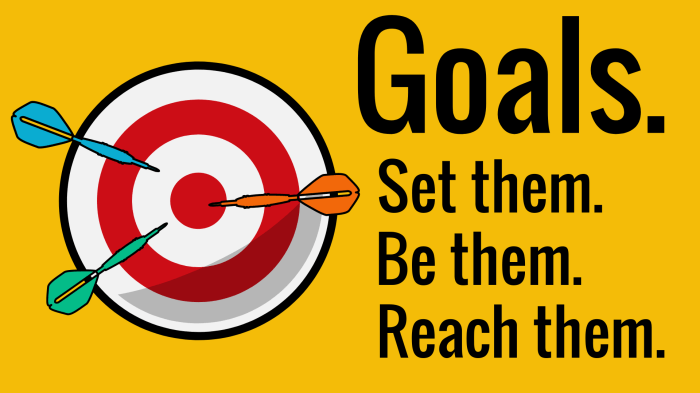When it comes to achieving your dreams, mastering Goal Setting Techniques is key. From defining goals to breaking them down into actionable steps, this guide will show you how to turn your aspirations into reality.
Learn from successful individuals who credit their accomplishments to effective goal setting strategies and discover the tools and resources that can help you track your progress along the way.
Introduction to Goal Setting Techniques
Goal setting is the process of identifying something that you want to accomplish and establishing measurable objectives and a plan to achieve it. It is essential because it provides direction, motivation, and a clear focus on what you want to achieve.
Setting goals can have numerous benefits in various aspects of life, including personal development, career advancement, and overall well-being. By setting specific, realistic, and achievable goals, individuals can track their progress, stay motivated, and improve their productivity.
Examples of Successful Individuals, Goal Setting Techniques
- Elon Musk, the CEO of Tesla and SpaceX, attributes his success to setting ambitious goals and working tirelessly to achieve them.
- Oprah Winfrey, media mogul and philanthropist, set goals to overcome adversity and build a successful empire from scratch.
- Michael Phelps, the most decorated Olympian of all time, set specific goals to break records and become a champion swimmer.
Types of Goal Setting Techniques

Setting goals is an essential aspect of personal and professional development. There are different types of goal setting techniques that individuals can utilize to achieve their objectives. Two common types include short-term goals and long-term goals. Short-term goals are typically achievable in a shorter period, such as daily or weekly goals, while long-term goals are broader objectives that may take months or even years to accomplish.
SMART Goals
SMART goals are a popular framework used in goal setting to ensure goals are specific, measurable, achievable, relevant, and time-bound. This approach helps individuals create clear and actionable objectives that increase the likelihood of success.
Importance of Realistic and Achievable Goals
Setting realistic and achievable goals is crucial for maintaining motivation and momentum. When goals are too lofty or unattainable, individuals may become discouraged and give up on their objectives. By setting goals that are challenging yet realistic, individuals can experience a sense of accomplishment and progress, fueling their motivation to continue striving for success.
Strategies for Effective Goal Setting

Setting goals is crucial for success, but knowing how to effectively set them can make all the difference. Here are some key strategies to help you set and achieve your goals:
Setting Specific and Measurable Goals
When setting goals, it’s important to be as specific and measurable as possible. Instead of saying “I want to exercise more,” try setting a goal like “I will go to the gym three times a week for at least 45 minutes each session.” This way, you can track your progress and know exactly what you need to do to reach your goal.
Breaking Down Larger Goals
Large goals can seem overwhelming, but breaking them down into smaller, manageable tasks can make them more achievable. Create a list of steps you need to take to reach your goal, and focus on completing one task at a time. This will help you stay motivated and make progress towards your ultimate goal.
Setting Deadlines and Milestones
Setting deadlines and milestones is essential for goal setting. Deadlines create a sense of urgency and help you prioritize your tasks. Milestones allow you to track your progress and celebrate small victories along the way. By setting deadlines and milestones, you can stay on track and motivated to achieve your goals.
Tools and Resources for Goal Setting
In today’s digital age, there are numerous tools and resources available to help individuals set and track their goals effectively. From apps to software programs, here are some popular options to consider:
Popular Apps and Software for Tracking Goals
- 1. Todoist: A task management app that allows you to set specific goals, deadlines, and reminders.
- 2. Strides: An app that helps you track your goals and habits with customizable trackers and progress charts.
- 3. Evernote: A note-taking app where you can create goal-specific notes, set reminders, and track your progress.
Creating a Vision Board
Visual representation can be a powerful tool in goal setting. One popular method is creating a vision board, where you gather images, quotes, and visuals that represent your goals and aspirations. To create a vision board:
- Gather magazines, printouts, or digital images that resonate with your goals.
- Arrange these visuals on a board or a digital platform like Pinterest to create a visual collage.
- Place your vision board in a prominent place where you can see it daily to stay motivated and focused.
Role of Journaling in Reflecting on Progress
Journaling can be a beneficial practice in reflecting on your progress, setbacks, and achievements related to your goals. By jotting down your thoughts and feelings regularly, you can:
- 1. Gain clarity: Writing about your goals and progress can help you clarify your thoughts and emotions.
- 2. Track patterns: Journaling allows you to identify patterns in your behavior that may be hindering or supporting your goals.
- 3. Adjust goals: Reflecting on your journal entries can help you adjust your goals and strategies accordingly for better outcomes.